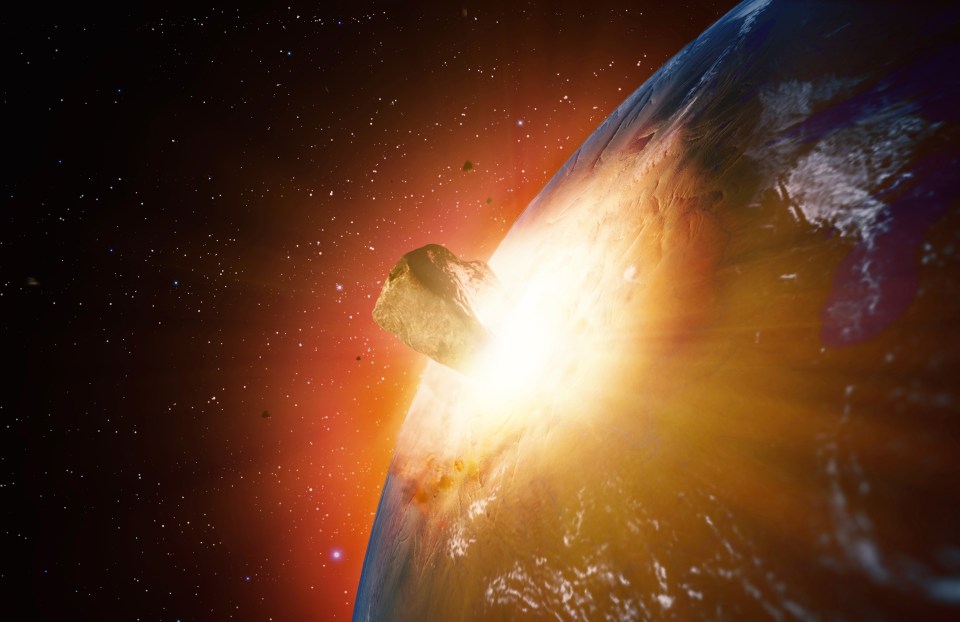NASA has revealed which countries could be hit if a “city killer” asteroid strikes Earth with a map of the risk corridor.
Scientists have slashed the odds of a collision between asteroid 2024 YRA and our planet to a one-in-43 chance – or just over two per cent.
GettyThe asteroid could strike Earth at Christmas time, 2032[/caption]
AFPAsteroid 2024 YR4 as observed by the Magdalena Ridge 2.4m telescope at the New Mexico Institute of Technology on January 27, 2025[/caption]
The giant boulder rocketed to the top of Nasa’s impact risk list when it was discovered – and its threat level has only crept up with further calculations.
Astronomers say it is between 40 and 100 metres wide, and would blow a city-sized crater into the Earth’s crust.
It could rip through the atmosphere at 38,000mph and wreak more devastation than 100 nuclear bombs.
European Space Agency (ESA) projections show the path could intersect with Earth’s orbit at Christmas time in 2032 – specifically 8.52am GMT on Wednesday, December 22.
And now, the world’s premier space agency has identified the areas that could be affected if the impact happens.
David Rankin, an engineer with Nasa’s Catalina Sky Survey Project, has sketched a “risk corridor” showing the channel where it could land.
Their calculations suggest it would fall somewhere within a band that runs from the top of South America, across the Pacific Ocean, through southern Asia, the Arabian sea and Africa.
Where exactly it strikes within that band will depend on the rotation of the earth.
The countries in the possible firing line include India, Pakistan, Bangladesh, Ethiopia, Sudan. Nigeria, Venezuela, Colombia and Ecuador.
Residents of these countries don’t need to panic yet – the chance of a collision is still very slim.
Agencies from nations across the world have been preparing planet defence programmes in preparation for diverting the asteroid, if required.
A special projects cell in China‘s State Department for Science and Technology has posted job adverts for three “planetary defence” posts.
The centre – China’s mission control for aerospace engineering – is taking on graduate science whizzes to advance asteroid monitoring and build early warning systems.
With rising concerns about the chances of impact, researchers have suggested various deflection methods – including solar lasers, nuclear bombs or – most likely – kinetic impactors.
The latter option involves scientists launching a spacecraft at the asteroid to knock it off orbit.
However, some experts have warned we may not have enough time to use that method.
Dr Robin George Andrews, a science writer, said on X: “I’ve often [been] told you need 10 years or more to build, plan and execute an asteroid deflection mission.
“Now let’s look at 2024 YR4. We have less than eight years to potentially deal with it, if needed.
“I’m not saying a kinetic impactor mission, or missions, couldn’t work.
“But we don’t have much time, and we don’t have enough info about this rapidly fading asteroid to properly inform our planetary defence decisions yet.”
Even if we did have time, he noted that the kinetic impactor method may not work.
NASA/Goddard/Arizona State UniversityScientists say the asteroid would leave a crater the size of a city if it hit Earth[/caption]
Another option for dodging disaster is to detonate a nuclear bomb near the the asteroid – and Dr Andrews urged researchers not to rule it out.
He suggested that scientists may “break an awkward taboo” of using a nuclear weapon against 2024 YR4 “which would provide a bigger punch than DART”.
The European Union-funded NEO Shield consortium said last week that the use of a nuclear bomb would be a last resort.
While the idea of sending a nuclear weapon into space to stop a potentially deadly asteroid sounds like fiction thanks to movies like Armageddon, it is one of the options available to scientists.
A carefully executed explosion close to the surface of the asteroid would be carried out in the hope that the rock shatters into smaller fragments that would burn up in the atmosphere.
GettyThere is now a list of countries that could be in the strike zone[/caption]

